This Week
 I spoke to the 3rd Annual Space Exploration Conference in Denver on Tuesday. Given that I am so often in front of aerospace crowds these days, it was a unique opportunity to involve the aerospace community in what we’ve been doing in outreach, particularly the Future Forums, and what is planned for the Future. I also introduced the new feature on NASA’s website, NASA Home and City, where you click on a particular item — on an airplane, at the grocery store, in the hospital, etc. — and see how it was derived from NASA technology or cooperation. It’s a fun tool.
I spoke to the 3rd Annual Space Exploration Conference in Denver on Tuesday. Given that I am so often in front of aerospace crowds these days, it was a unique opportunity to involve the aerospace community in what we’ve been doing in outreach, particularly the Future Forums, and what is planned for the Future. I also introduced the new feature on NASA’s website, NASA Home and City, where you click on a particular item — on an airplane, at the grocery store, in the hospital, etc. — and see how it was derived from NASA technology or cooperation. It’s a fun tool.
With the rollout of the FY2009 budget, Mike Griffin testified last week before the House Science & Technology Committee. Next week he testifies before House Appropriations and April 4 before Senate Appropriations.
Governor’s Remarks from Columbus Future Forum
Ohio Governor Strickland’s remarks at the Columbus Future Forum last week were fabulous [(read transcript (PDF)]. He said, “NASA’s space exploration and research efforts have not only opened corners of the universe, they have improved life on this planet. NASA’s countless advances affect our daily lives and energize our economy. In materials, medicine, biology, fuel economy, aviation, information technology, and telecommunications NASA has sped our path to the future.”
Washington Lt. Governor Owen’s remarks at the Seattle Future Forum were similarly striking [read transcript (PDF), listen to speech (MP3)]. He said, “NASA, more than any government organization, has been the seed of inspiration and imagination for millions around the country and the world. The seeds that NASA has planted in its space programs have sowed nothing short of miracles and accomplishment, reaching far beyond the extraordinary technology that launched men and women into space time and again.” You can see from both speeches that these leaders understand the importance of space to communities in their states. That is the goal of the Future Forums and these forums are proving to be very effective.
Introduction of John Hairston’s Posting
John Hairston, Director of External Relations at Glenn Research Center, participated in the Columbus Future Forum. Under John’s leadership, Glenn has been out in front in thinking of innovative means to reach out to local communities in Ohio. John’s posting on some of these planned and ongoing activities is below.
Glenn Outreach by John Hairston
Since listening to Shana Dale’s keynote address about the space economy at the Columbus Future Forum, I’ve been thinking about how NASA’s Glenn Research Center contributes to the space economy through outreach to government officials, businesses, educational institutions and the general public. As Glenn prepares to coordinate its 2007 Economic Impact study, we’re reflecting on the many ways that our Center adds value to Ohio. I’d like to share with you a few of the unique outreach opportunities we’re pursuing this year with four key audiences.
Government
Ohio is unique in the nation. It has a vast aerospace industry that is supported by an outstanding higher education system, but it lacks a state-wide aerospace strategy. To address this issue, Glenn is collaborating on the planning and execution of the first-ever Ohio Aerospace Day. The event will gather government, industry, academic and economic development institutions to increase awareness of Ohio’s aerospace industry among key federal and state leaders and to exchange ideas on public policies and strategic partnerships.
Business
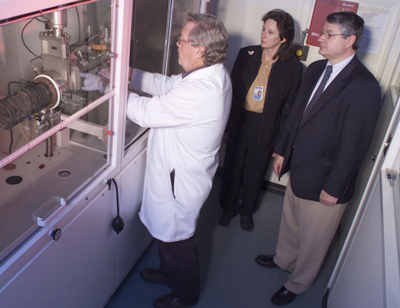 Ohio companies have always been involved in the space program — over 52 of them have supplied the space shuttle — and we expect them to continue to play a strong role in the Constellation Program. To make sure that happens, on May 16, 2008, Glenn will host area businesses for a series of workshops designed to introduce them to the U.S. Space Exploration Policy and help them identify potential roles for their companies.
Ohio companies have always been involved in the space program — over 52 of them have supplied the space shuttle — and we expect them to continue to play a strong role in the Constellation Program. To make sure that happens, on May 16, 2008, Glenn will host area businesses for a series of workshops designed to introduce them to the U.S. Space Exploration Policy and help them identify potential roles for their companies.
This fiscal year, Glenn also entered into NASA’s first inter-agency agreement with the U.S. Navy to help companies accelerate the commercialization of technologies funded by the Small Business Innovative Research Program. The companies will present their technologies in a NASA Showcase at the 8th Navy Opportunity Forum on June 2-4 in Crystal City, Virginia.
Education
Glenn’s Education office has joined forces with the Cleveland Municipal School District to open a school that is like no other public school in the United States. At this science, technology, engineering and math (STEM) high school, students will participate in an integrated curriculum that fosters critical thinking, creativity and communication. Academics will emphasize how math, science and technology shape our world. The school is named MC2 STEM, and it will open in the fall of 2008. We’re also collaborating with several educational organizations to provide classroom and online content for an Ohio Department of Education professional development plan for science teachers.
Public
The Office of Community and Media Relations engages the community both outside and within Glenn’s gates. On the Third Saturday of every month, Glenn’s Visitor Center staff invites the public to join them for a full day of presentations, exhibits and activities for the whole family. The Third Saturday events bring more than 9,000 guests to the Visitor Center every year.
Outside of Glenn’s gates, Glenn’s Speakers Bureau reaches more than 60,000 people a year and is comprised of scientists, engineers and other Glenn employees who educate the public on topics ranging from NASA careers to space exploration. This year, under the direction of Center Director, Dr. Woodrow Whitlow Jr., Glenn’s senior management team is joining the Speakers Bureau.
 |
 |

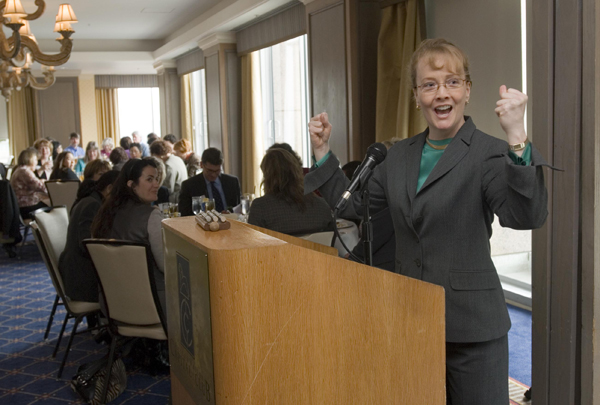 On Tuesday, I spoke at the National Association of Women Business Owners, Silicon Valley Chapter (NAWBO-SV), first annual awards luncheon in San Jose, California.
On Tuesday, I spoke at the National Association of Women Business Owners, Silicon Valley Chapter (NAWBO-SV), first annual awards luncheon in San Jose, California.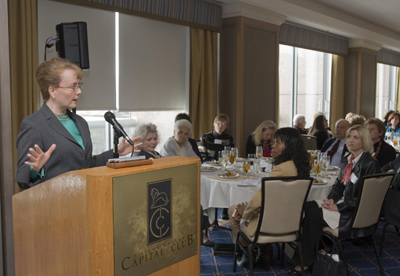 Ms. Cecelia (Ceil) McCloy, President and CEO of Integrated Science Solutions, Inc. (ISSi), received the NAWBO-SV Public Policy Advocate of the Year Award for 2008. In a previous blog, I mentioned that ISSi was named 2007 Small Business Administration Region IX Prime Contractor of the Year. This award honors small businesses that have provided the federal government with outstanding goods and services as prime contractors. ISSi, a certified woman-owned science and engineering firm started in 1999, supports NASA Ames by performing the Environmental Support Services Contract at the Center.
Ms. Cecelia (Ceil) McCloy, President and CEO of Integrated Science Solutions, Inc. (ISSi), received the NAWBO-SV Public Policy Advocate of the Year Award for 2008. In a previous blog, I mentioned that ISSi was named 2007 Small Business Administration Region IX Prime Contractor of the Year. This award honors small businesses that have provided the federal government with outstanding goods and services as prime contractors. ISSi, a certified woman-owned science and engineering firm started in 1999, supports NASA Ames by performing the Environmental Support Services Contract at the Center.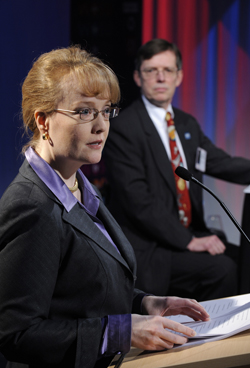 On Thursday, I gave the opening
On Thursday, I gave the opening 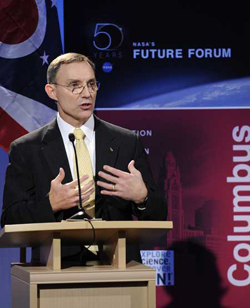 The agenda highlights also included a presentation from astronaut Carl Walz and a taped downlink from ISS Commander Peggy Whitson. Carl is also the Director, Advanced Capabilities Division at NASA Headquarters. He gave a presentation on the Constellation Program. Other NASA participants included Woodrow Whitlow, director of NASA’s Glenn Research Center; Glenn Director of External Relations, John Hairston; and Dr. Geoffrey Landis, also from Glenn. I appreciate the time and effort of our NASA participants in the Future Forum as well as the NASA and partner teams behind the scenes who worked so hard on this event.
The agenda highlights also included a presentation from astronaut Carl Walz and a taped downlink from ISS Commander Peggy Whitson. Carl is also the Director, Advanced Capabilities Division at NASA Headquarters. He gave a presentation on the Constellation Program. Other NASA participants included Woodrow Whitlow, director of NASA’s Glenn Research Center; Glenn Director of External Relations, John Hairston; and Dr. Geoffrey Landis, also from Glenn. I appreciate the time and effort of our NASA participants in the Future Forum as well as the NASA and partner teams behind the scenes who worked so hard on this event.